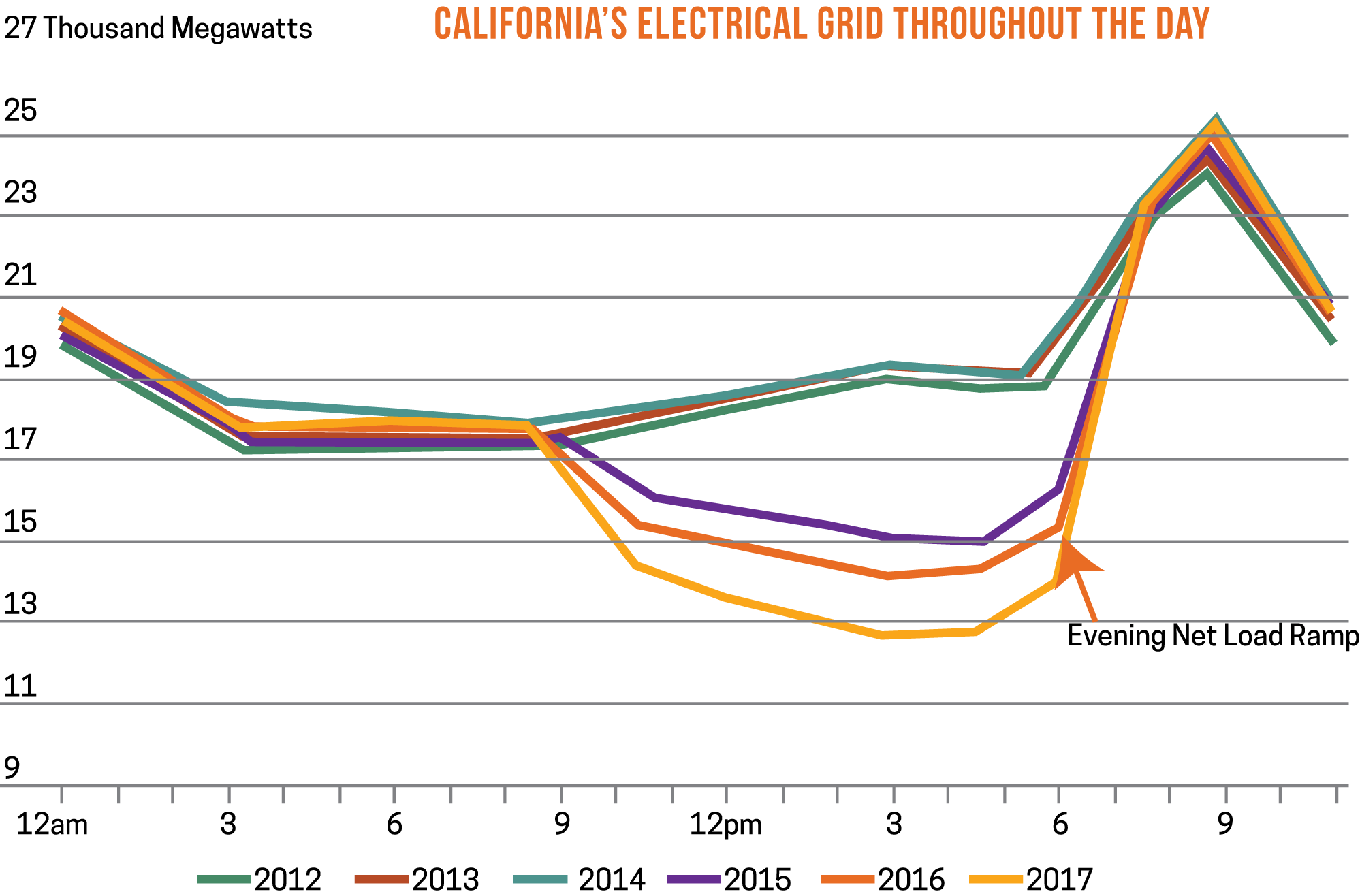What the Worst Gas Leak in US History Means for Demand Response in California this Summer
Demand response participants will play an essential role in keeping Southern California’s energy grid stable this summer. Here are a few reasons why and a few insights on how DR customers can position themselves for a successful season.
The leak at Aliso Canyon has consequences for energy supply in California.
In October 2015, Aliso Canyon— the largest natural gas storage facility in California—suffered a leak in the LA Basin/Porter Ranch area, resulting in the emission of more than 97,000 metric tons of methane. To put the tonnage in perspective, the leak produced enough methane gas each day to fill a balloon the size of the Rose Bowl. The leak was plugged after 112 days.
The fallout has proven costly for the natural gas infrastructure in Southern California. According to the “Aliso Canyon Risk Assessment Technical Report,” the leak reduced Aliso Canyon’s gas stores to less than 20% of its capacity.
Low capacity means high risk for blackouts this summer.
The drop in capacity could cause trouble for the 17 natural gas generators served by the Aliso Canyon facility if (and when) electric demand is high this summer. The Assessment Report also warns that millions of California customers may suffer an interruption in electrical service during as many as 14 days this summer when demand is expected to be at its highest.
The grid will be at its most fragile in the evenings when the sun sets, causing a drop in available solar resources. The drop in solar coincides with a spike in demand as people come home from work and flip on their air conditioning.

Demand Response will help grid reliability.
The joint agencies that produced Aliso Canyon Assessment Report have also drafted an Aliso Canyon Action Plan that calls for, among other mitigation strategies, demand response to help keep the grid stable in the LA Basin this summer.
California’s Base Interruptible Programs (BIP), in which participants provide load reduction on a day-of basis in Southern California Edison’s (SCE) and Pacific Gas and Electric’s (PG&E) service territory, allows for fast dispatching of emergency resources and is therefore expected to be heavily utilized to alleviate grid stress in Southern California this summer

How energy prices may trigger key curtailment programs:
Summer electricity prices may climb high enough to trigger SCE’s Aggregator Managed Portfolio (AMP) program, as well as statewide Demand Response Auction Mechanism (DRAM) programs, which aim to offset grid stress and avoid potential blackouts by reducing load via demand response.
Due to the high amounts of solar and other renewable generation available in California during the call hours of these programs, overall energy prices are not as tightly correlated with natural gas as they can be in other states.
The gas shortage caused by the leak at Aliso Canyon will drive heat rate levels in the LA Basin. This will cause natural gas heat rate triggered programs like CAISO’s Capacity Bidding Program (CBP) in PG&E to have a potentially higher instance of calls this summer.
Preparation is the key to successful demand response.
This summer, more so than in previous seasons, demand response will be a crucial component of grid reliability! When the grid sends out its distress notice, time will be of the essence to avoid blackouts. Make sure your curtailment plans are in place and your curtailment personnel are at the ready.
CPower can help answer any questions you may have to help you prepare for the summer season. Click HERE to contact our California team.
CPower joins forces with iDR Press Release
CPower appoints Glenn Bogarde to Senior VP of Sales
CPower Expanding its Demand Response Portfolio
Get Started CPower Thank You
Terms & Conditions
Privacy Policy
Rhode Island Hospital: A “Shining Example” of Optimized Demand Response
When electricity prices in New England were on the rise in 2014/2015, Rhode Island Hospital braced for an energy spend they thought would lead a $1 million budget deficit.
With demand response and CPower’s energy management team in their corner, the hospital’s actual energy spend was much more favorable.
By participating in the ISO New England’s three demand response programs (Transitional Price Responsive Demand (TRPD), Real Time Demand Response and Real Time Emergency Generation) Rhode Island Hospital managed to offset their energy spend with the kind of efficiency that should make other New England hospitals take notice.
“We ended up breaking even,” said Marc Leduc, the Chief Engineer at the hospital’s on-site power plant. “A lot of it was due to those [demand response] programs.”
Founded in 1863, The Rhode Island Hospital is the principal teaching hospital of The Warren Alpert Medical School of Brown University. It is also a major trauma center for southeastern New England, and home to Hasbro Children’s Hospital, the state’s only facility dedicated to pediatric care.
In the mid-1970’s, Rhode Island Hospital constructed a cogeneration power plant on its grounds to provide electricity for the hospital’s day to day needs. Today, that power plant produces roughly 50% of the energy the hospital uses. Cost, particularly the cost of natural gas which the plant uses to create electricity, is a crucial factor in determining how the hospital manages its energy.
“Every dollar the hospital can save on electricity is a dollar that can be spent providing better medical care for the patients,” said Mr. Leduc. “Demand response helps keep us on budget by offsetting the cost of energy, especially during years when the price of gas is high.”
Bill Cratty, CPower’s Senior Technical Sales Associate for the New England region, initially enrolled Rhode Island Hospital in the ISO-NE’s demand response programs in 2007. Since then, he has worked closely with the Providence-based health care facility to help fine tune its demand response participation. Today he believes Rhode Island Hospital is a model to which other New England hospitals should look when considering how to offset their own energy costs.
“Rhode Island Hospital is a shining example of what a hospital can do to optimize their energy management,” Mr. Cratty said. “By participating in the TPRD program, they not only avoided purchasing electricity from the utility, but also got paid by ISO-NE for the amount of electricity they generated and bid into the day ahead market. The hospital consumed all of the electricity it generated. The payment it received from its demand response participation more than offset the cost to generate, so the hospital essentially received a significant portion of its energy usage at a negative cost.”
University of Maryland, Baltimore
A commendable effort to reduce energy load and lesson carbon impact.
In 2006, the State of Maryland passed legislation which required that energy consumption for all state buildings must be reduced by 5% in 2009 and 10% in 2010. The University of Maryland, Baltimore (UMB) was already ahead of the game; examining efficiency programs to find cost-effective measures to save energy and expenses on its campus.
Working with PJM Interconnection, the regional transmission organization (RTO), and Comverge, Inc., [CPower] a leading provider of clean energy solutions through Demand Response, Michael Krone, PE, CEM utility operations manager for UMB, found:
“By serving as our curtailment service provider (CSP), or broker, in the PJM DR programs, Converge [CPower] facilitated the reduction of our peak demand and overall consumption, which ultimately helped reduce our carbon footprint and emission levels. Comverge provided the resources to monitor real-time market pricing, develop load profiles, and create customer baselines. Comverge’s graphical tools have been invaluable to our success in the PJM DR programs.”
UMB enrolled in Comverge’s Real-Time Economic Load Response and its Reliability Pricing Model (RPM) programs. These programs offered assistance from energy analysts and delivered load profiling and IT support, consumption analytics and graphics, and other conservation initiatives.
Strategies
With the help of Comverge [CPower], UMB implemented strategies that reduced its energy load and helped meet the new legislative requirements:
- Using an existing 20,000 ton-hour/2,000- ton output thermal storage system to shift air conditioning loads from daytime on-peak operation to nighttime off-peak operation.
- Remotely controlling lighting in public areas and turning off all non-essential lighting during periods of high demand.
- Switching lighting and HVAC loads in real time via remote control from occupancy sensors local building automation systems.
- Temporarily raising HVAC return-air set points for 30 minutes or less to reduce cooling demand. Since the level of thermal inertia for a building is typically 45 minutes or more, this effort is transparent.
- Placing a portion of chilled water production on a current limiting mode for 30-minute periods. To ensure this activity remains transparent to the building occupants, only a fraction of overall production is in conservation mode at any given time, and the operation shifts between facilities.
- Deploying a Building Automation Network that monitors and controls the individual automation system(s) in each building from a central location.
Results
UMB reduced its load by more than 20,000,000 kWh in just two years. That’s the equivalent of two months of the school’s electrical consumption, or powering 10,000 homes for the same period.
“University of Maryland, Baltimore is a great example of what just one campus can do to reduce its energy load and lessen its carbon impact. The university should be commended for its innovation and forward thinking.”
─ George Hunt, Comverge senior vice president, Commercial Sales
The City of Danville Finds Success with Demand Response and CPower
AMP Member passes ordinance, increases revenues through energy reduction
Hardworking businesses form the backbone of the City of Danville, Virginia. When it comes to overseeing the energy needed to run the city’s economic engine, Danville Utilities—the City of Danville’s electrical department—understands the need to maintain the balance between consumption and conservation.
“As a municipal utility, we are always encouraging our customers to find ways to save energy,” says Meagan Baker, Danville Utilities’ Key Accounts Manager. The City of Danville — an AMP member municipality — perpetually seeks ways that not only allow their customers to conserve energy, but also allow the utility to save on congestion and transmission charges during the most critical peak times of the year.
Enter demand response and, what the City of Danville calls, “a win-win situation for the utility and the customer.”
In early 2014, the City of Danville adopted a resolution authoring their participation in the PJM demand response program for retail customers. The resolution allowed Danville’s city manager to execute an agreement with American Municipal Power approving the city’s participation in PJM’s demand response programs, which pay businesses for reducing their energy use during the few times each year when the PJM grid is stressed.
The agreement also named CPower as the City of Danville’s exclusive PJM curtailment service provider in charge of implementing and facilitating the city’s demand response. Danville Utilities believes their customers couldn’t be in more capable hands.
“CPower has been a great source for implementing our demand response program. Bill Oosterom, our account manager, has been our go-to person from start to finish. From educating customers about the program, getting them enrolled and assisting with any questions and/or concerns they have along the way, the process has been very transparent and straightforward. This streamlined approach makes it easier for our customers as well.” – Meagan Baker Key Accounts Manager, City of Danville
The City of Danville Finds Success with Demand Response and CPower
CPower’s hands-on style of energy management includes the kind of customer-focused touch the business owners of Danville appreciate. CPower’s Bill Oosterom believes that being personally involved in his customers’ demand response participation is a key reason the City of Danville has enjoyed energy management success.
“No two businesses are alike,” says Mr. Oosterom, who has more than 33 years of experience as an energy consultant. “Demand response shouldn’t be a set-it-and-forget-it process. At CPower, we work closely with all our customers to fine tune their demand response participation over time and ensure they get the maximized results and revenue they deserve.”
So far, the results from the City of Danville’s demand response participation have proven to be substantial. Participating customers have earned significant revenue through demand response (more than $97,000 in aggregate for the 2015-2016 program years), with many businesses choosing to put their earnings toward energy efficient upgrades or other capital improvement projects.
Even the City of Danville, itself, has participated in demand response with great success. Facing a need to offset operational costs, the City of Danville enrolled its municipal-owned water and wastewater treatment plants in the program and have now earned valuable revenue (more than $30,000 for the 2015/2016 program) to help budgets of future projects. Civic leaders feel the City of Danville’s involvement in demand response provides a lead-by-example model of energy management. “We are always asking our customers to conserve,” says Meagan Baker, “so we must practice what we preach.”
For the City of Danville, the future looks bright as the number of businesses in their municipality participating in demand response is on the rise. With CPower and demand response on their side, the City of Danville is poised to do their part to keep the grid in balance, the environment in good health, and their hardworking customers in expert hands when it comes to energy management.
“The program has been very beneficial in educating our customer base on the importance of energy efficiency and demand response. As our customers continue to succeed, I believe the word will spread, positively influencing other customers to also become involved. We are excited to grow the program.” — Meagan Baker
AMP urges you to pass your local demand response ordinance as quickly as possible, to ensure that there is ample time for program participants to be registered for the 2017-2018 program year.






